POLYNOMIAL FUNCTION
A polynomial function is a function such as a quadratic, a cubic, a quadratic, and so on, involving only non-negative integer powers of x. We can give a general definition of a polynomial, and
define its degree.
THE INTERCEPTS
The graphical concept of x- and y-intercepts is pretty simple. The x-intercepts are where the graph crosses the x-axis, and the y-intercepts are where the graph crosses the y-axis. The problems start when we try to deal with intercepts algebraically.
an x-intercept is a point on the graph where y is zero, and a y-intercept is a point on the graph where x is zero.
Find the x- and y-intercepts of 25x2 + 4y2 = 9
Using the definitions of the intercepts, I will proceed as follows:
x-intercept(s):
y = 0 for the x-intercept(s), so:
25x2 + 4y2 = 9
25x2 + 4(0)2 = 9
25x2 + 0 = 9
x2 = 9/25
x = ± ( 3/5 )
Then the x-intercepts are the points ( 3/5, 0) and ( –3/5, 0)
y-intercept(s): Copyright © Elizabeth Stapel 1999-2011 All Rights Reserved
x = 0 for the y-intercept(s), so:
25x2 + 4y2 = 9
25(0)2 + 4y2 = 9
0 + 4y2 = 9
y2 = 9/4
y = ± ( 3/2 )
Then the y-intercepts are the points (0, 3/2 ) and (0, –3/2 )
THE TURNING POINTS
A turning point of a function is a point where the graph of the function changes from sloping
downwards to sloping upwards, or vice versa. So the gradient changes from negative to positive,
or from positive to negative. Generally speaking, curves of degree n can have up to (n − 1)
turning points.
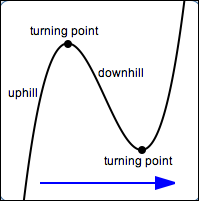
Subtopic
The polynomial
y=x3
y=x3 has no turning points.
It has a horizontal tangent line at
(0,0)
(0,0) which is not a turning point.
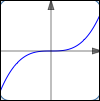
Subtopic
NO TURNING POINT
MULTIPLICITY OF A ROOT
Root of multiplicity 1 is also called a simple root.
A zero has a "multiplicity", which refers to the number of times that its associated factor appears in the polynomial. For instance, the quadratic (x + 3)(x – 2) has the zeroes x = –3 and x = 2, each occurring once. The eleventh-degree polynomial (x + 3)4(x – 2)7 has the same zeroes as did the quadratic, but in this case, the x = –3 solution has multiplicity 4 because the factor (x + 3) occurs four times (that is, the factor is raised to the fourth power) and the x = 2 solution has multiplicity 7 because the factor (x – 2) occurs seven times.
The point of multiplicities with respect to graphing is that any factors that occur an even number of times (that is, any zeroes that occur twice, four times, six times, etc) are squares, so they don't change sign. Squares are always positive. This means that the x-intercept corresponding to an even-multiplicity zero can't cross the x-axis, because the zero can't cause the graph to change sign from positive (above the x-axis) to negative (below the x-axis), or vice versa.
The practical upshot is that an even-multiplicity zero makes the graph just barely touch the x-axis, and then turns it back around the way it came. You can see this in the following graphs:
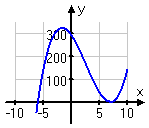
Subtopic
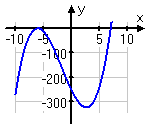
Subtopic
Subtopic
Subtopic
The degree of a polynomial is the highest power of x in its expression. Constant (non-zero)
polynomials, linear polynomials, quadratics, cubics and quartics are polynomials of degree 0, 1,
2 , 3 and 4 respectively. The function f(x) = 0 is also a polynomial, but we say that its degree
is ‘undefined’.
RATIONAL ZEROS OF POLYNOMIAL
We can use the Rational Zeros Theorem to find all the rational zeros of a polynomial. Here are the steps:
1)Arrange the polynomial in descending order
2)Write down all the factors of the constant term. These are all the possible values of p .
3)Write down all the factors of the leading coefficient. These are all the possible values of q .
4)Write down all the possible values of . Remember that since factors can be negative, and - must both be included. 5)Simplify each value and cross out any duplicates.
6)Use synthetic division to determine the values of for which P() = 0 . These are all the rational roots of P(x) .
Example: Find all the rational zeros of P(x) = x 3 -9x + 9 + 2x 4 -19x 2 .
1) P(x) = 2x 4 + x 3 -19x 2 - 9x + 9
2 )Factors of constant term: ±1 , ±3 , ±9 .
3)Factors of leading coefficient: ±1 , ±2 .
4)Possible values of : ± , ± , ± , ± , ± , ± . These can be simplified to: ±1 , ± , ±3 , ± , ±9 , ± .
5)Use synthetic division:

DIVIDING POLYNOMIALS

Step 1: Set up the synthetic division.

Step 2: Bring down the leading coefficient to the bottom row.
Subtopic

Step 3: Multiply c by the value just written on the bottom row.
Subtopic

Step 4: Add the column created in step 3. Write the sum in the bottom row:
Step 5: Repeat until done.
UPPER AND LOWER BOUND
Upper Bound
If you divide a polynomial function f(x) by (x - c), where c > 0, using synthetic division and this yields all positive numbers, then c is an upper bound to the real roots of the equation f(x) = 0.
Note that two things must occur for c to be an upper bound. One is c > 0 or positive. The other is that all the coefficients of the quotient as well as the remainder are positive.
Lower Bound
If you divide a polynomial function f(x) by (x - c), where c < 0, using synthetic division and this yields alternating signs, then c is a lower bound to the real roots of the equation f(x) = 0. Special note that zeros can be either positive or negative.
Example 1: Show that all real roots of the equation example 1a lie between - 4 and 4.
In other words, we need to show that - 4 is a lower bound and 4 is an upper bound for real roots of the given equation.
Checking the Lower Bound:
Lets apply synthetic division with - 4 and see if we get alternating signs:

Note how c = -4 < 0 AND the successive signs in the bottom row of our synthetic division alternate.
You know what that means?
- 4 is a lower bound for the real roots of this equation.
Checking the Upper Bound:
Note how c = 4 > 0 AND the all of the signs in the bottom row of our synthetic division are positive.
You know what that means?
4 is an upper bound for the real roots of this equation.
Since - 4 is a lower bound and 4 is an upper bound for the real roots of the equation, then that means all real roots of the equation lie between - 4 and 4.

LEADING COEFFICIENT TEST
Each real number aiis called a coefficient. The number that is not multiplied by a variable is called a constant. Each product
is a term of a polynomial. The highest power of the variable that occurs in the polynomial is called the degree of a polynomial. The leading term is the term with the highest power, and its coefficient is called the leading coefficient.
IDENTIFY THE LEADING COEFFICIENT
Find the highest power of x to determine the degree.
Identify the term containing the highest power of x to find the leading term.
Identify the coefficient of the leading term.
